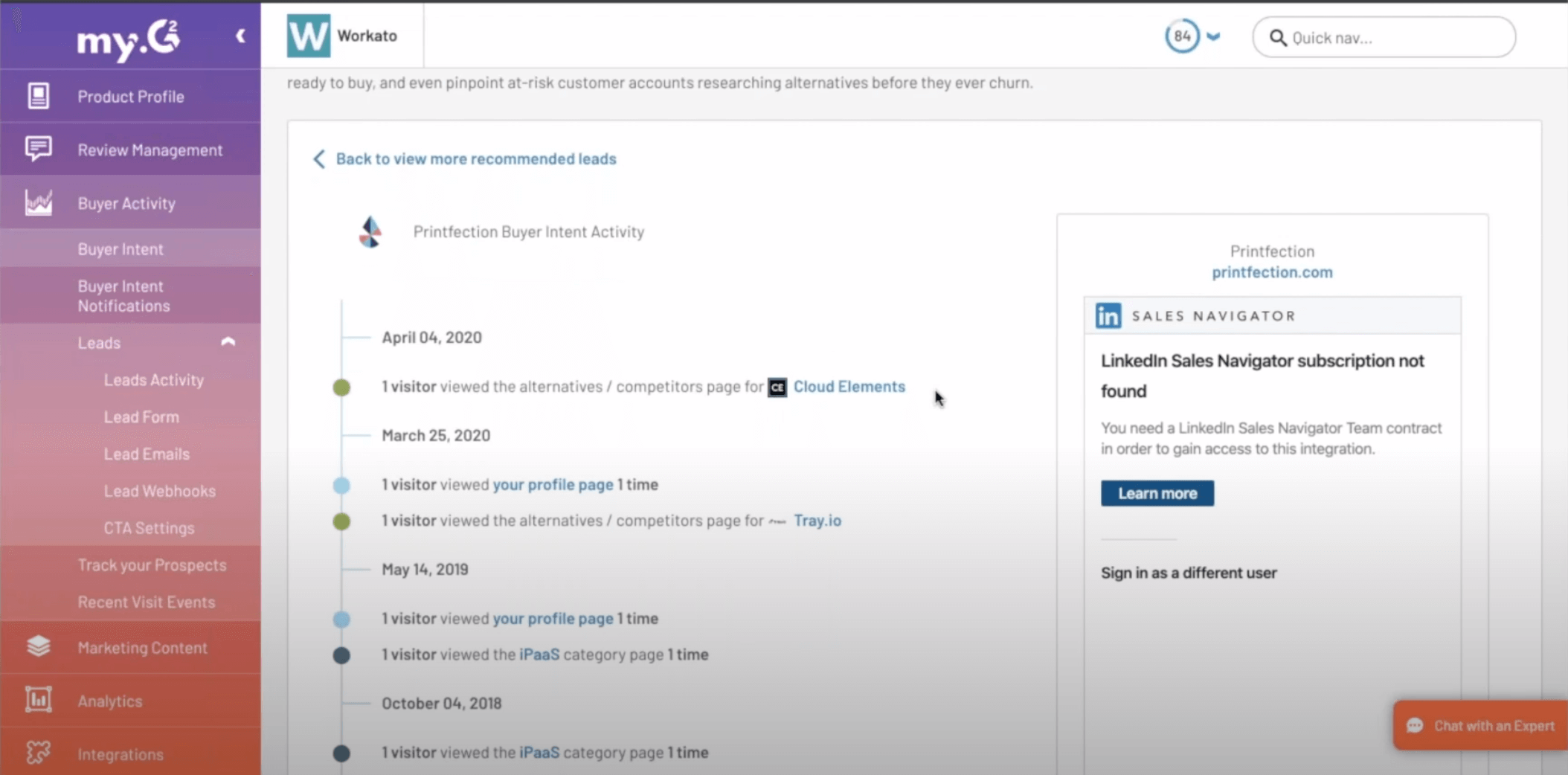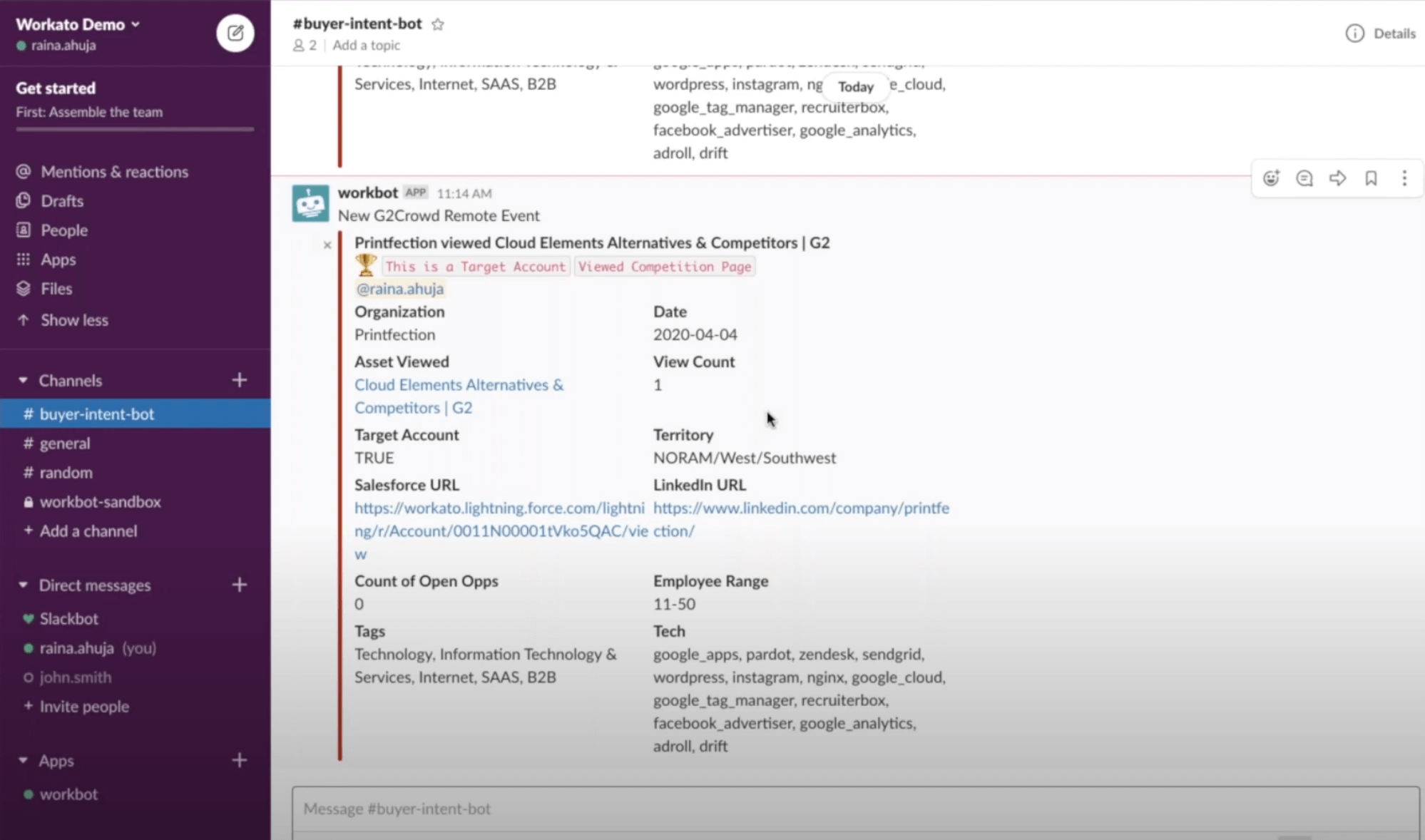Reach potential customers faster with the Buyer Intent Bot

The B2B sales process has become harder without face-to-face ways to get to know prospective customers and the overall market. For now, no more conferences, where you could see who’s cruising past your exhibit booth (or your competitors’) and maybe stopping to pick up company swag or ask questions. No more hands-on demo sessions or cozy chats over meals to learn more about people’s pain points and how your product might address them.
Of course, customers still have plenty of digital ways to research potential solutions. Likewise, you have ways to figure out who might be in the market for what you’re offering, and how to reach them earlier in the process. But it does require you to up your game.
Workato’s here to help. We recently started sharing “Unexpected Automations,” clever ways of connecting applications and data sources to streamline routine business processes and find new value and relevance, developed by customers or for in-house use. One of the first we’ve introduced is the Buyer Intent Bot.
The Buyer Intent Bot helps sales reps target prospective customers long before they reach out to a vendor by spotting “digital footprints” indicating interest. Then, Buyer Intent Bot enriches those signals with helpful contextual information and serves up those potential leads to the right people. (These include not just sales reps but related teams in marketing and elsewhere, for an effectively coordinated whole-of-business approach called Revenue Operations, or RevOps.)
Read their signals to gauge buyers’ intentions
First, some background if you’re not familiar with what “buyer intent” is. Making a B2B purchase is a data-driven process — no wonder, since the price tag can reach six or seven figures and replacing a bad choice can be painful. Prospective buyers do a lot of research to figure out what options are available and how they stack up against the priorities and benchmarks they’ve drawn up. Meanwhile, you as a vendor want to know when organizations are shopping for the kind of solution you sell; clearly it’s more productive to reach out to the ones who already have an active intention to buy, versus just cold-calling.
But it’s rare that prospective buyers will start the process by telling you that they’re in the market — let alone what their list of priorities looks like and what other competitors they’re looking at. (In fact, about 70 percent of a buyer’s journey is complete by the time they first talk to a vendor.)
So how can you detect their buying signals? (Short of putting cameras in the outfield and banging on garbage cans.) The answer: Make use of buyer intent data — the digital footprints they leave during the research process.
Strong signs of interest include:
- Checking out product info on your own and competitors’ sites
- Checking out review sites such as G2 and TrustRadius — a very important step because buyers consider reviews an impartial and trustworthy source of information. In fact, by some estimates 52% of buyers use reviews in their purchase process.
When you know a prospect is interested, you can reach them earlier, with a better chance of shaping the conversation to highlight your offerings. (Early outreach is especially helpful if you use ABM or account-based marketing for RevOps. Your marketing and sales teams can coordinate their efforts more effectively when they share a better sense of what prospects are looking for.)
The right data, right when you need it
Knowing this, we at Workato built the Buyer Intent bot to automate these steps:
1) Track events like visits on your own product page, product alternatives pages, or competitor comparison pages. (You can break down the page visit data by time and visitor domain.)
2) Stitch together relevant information from your CRM apps, such as Salesforce, and other relevant information such as the target company’s LinkedIn profile, for context.
3) Push that information (including whether or not the interactions came from target accounts) right into the hands of your sales team, via Slack in real time.

The Buyer Intent Bot tracks signs of interest in your solution, such as site visits, and adds helpful backgrounds from sources such as LInkedIn.
Data alone is no silver bullet
Keep in mind that website visit data by itself is not the silver bullet. The value we hope to deliver with the Buyer Intent Bot comes through two other features:
- Introducing that data into your existing systems so you can combine it with your own data and scoring models. That helps you identify the Ideal Customer Profile (ICP) you’re aiming at, in terms of size, geography, industry, growth rate, and more.
- Directing this enriched buyer behavior data to sales teams without disrupting their workflows.
Just the good stuff
We realize a recipe, or automation, that turned every click on a research site into a Slack notification would overwhelm the sales reps with a lot of low-value alerts. So we built in the ability to customize this so it surfaces only the important opportunities.
You can set which types of events you’d like your reps to receive Slack notifications for. Maybe it’s for all target account engagements. Or maybe it’s only when people visit specific competitors’ pages, or when the companies that are engaging are above a certain size or show very high levels of intent. You can filter out accounts too — say, the wrong customer size or industry for your ICP.

The bot creates alerts in Slack when targeted companies show signs of interest.
Focusing on interested buyers pays off
Using this bot internally has paid off for our RevOps team — which is why we’re sharing it. Our early findings:
- Having all the buyer intent information in the context of apps they’re already using has helped our business development team ramp up quickly. Because they don’t have to keep switching context and can easily take action based on validated information, they can really focus on nailing the message and giving customers a great first impression.
- Speed is a big advantage. We were able to reach out to prospects within minutes — often while they were still on the Workato site. This can make a difference because they’re still thinking about their problem, so we can have a great conversation that sets the discovery call up for success. And that puts the whole rest of the sales cycle on a better footing.
- Despite the challenges of the overall economy, we haven’t seen a decrease in meetings booked. In fact, shortly after we started using the Buyer Intent Bot ourselves, our sales team had a record-breaking month in terms of outbound meetings booked and sales pipeline created.
Our findings, by the numbers:
- Less than four minutes to connect to a sales lead
- Three-fold increase in the meetings conversion rate
- Sales cycles are two times faster!
We can’t promise you’ll see the same results… but we do encourage you to check it out with this demo.
Expect surprising tips and tricks in future Unexpected Automations
This was just the first installment in our Unexpected Automations series, energetic, bite-sized (25-minute) sessions we hold live at 11 AM Pacific Time every other Wednesday. We’ve already rolled out a second session, on optimizing SaaS spend and a third leveraging your Snowflake data warehouse for more effective product usage insights. Our next will be May 20, on optimizing your Sales Ops processes.
If you can’t make it in real time, these presentations will be posted on YouTube. For more automations, you can browse our recipe collections, curated groups of recipes to solve a specific business problem.
And if reading all this has gotten you curious about what Workato can do for you, click here for a custom demo.